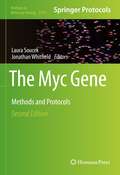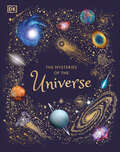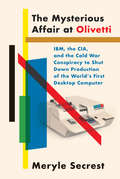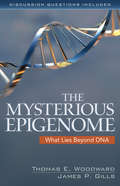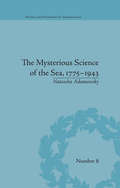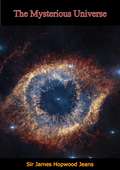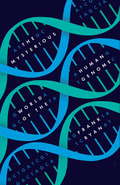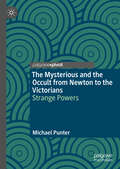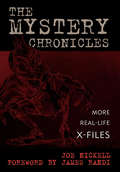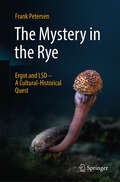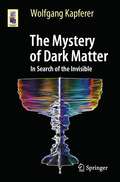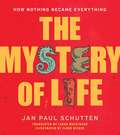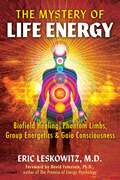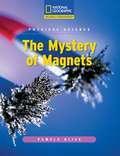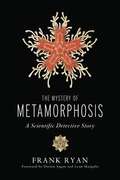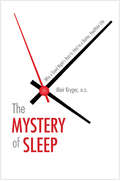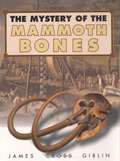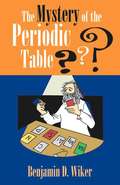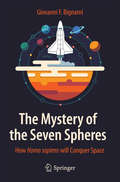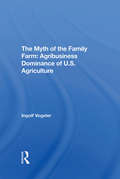- Table View
- List View
The Myc Gene: Methods and Protocols
by Nicole M. Sodir Laura SoucekMyc controls multiple cellular functions, including cell proliferation, growth, differentiation and death, both directly and indirectly, through its modulation of downstream transcriptional programs. In The Myc Gene: Methods and Protocols, experts in the field summarize the standard and novel techniques that allow the studying of Myc mechanism of action in normal and cancer cells, in vitro and in vivo, in one succinct manual. Written in the highly successful Methods in Molecular Biology series format, chapters include introductions to their respective topics, lists of the necessary materials and reagents, step-by-step, readily reproducible laboratory protocols, and key tips on troubleshooting and avoiding known pitfalls.
The Myc Gene: Methods and Protocols (Methods in Molecular Biology #2318)
by Laura Soucek Jonathan WhitfieldThis second edition provides new and updated chapters detailing recent advances in MYC research and current techniques. Chapters guide readers through protocols on how to express and purify MYC protein, X-ray crystallography, NMR, techniques to study how MYC is modified, apoptosis, senescence, proliferation, metabolic changes, translation, tumorigenesis,reprogramming, and clinical application of MYC studies.Written in the highly successful Methods in Molecular Biology series format, chapters include introductions to their respective topics, lists of the necessary materials and reagents, step-by-step, readily reproducible laboratory protocols, and tips on troubleshooting and avoiding known pitfalls. Authoritative and cutting-edge, The Myc Gene: Methods and Protocols, Second Edition aims to ensure successful results in the further study of this vital field.
The Mysteries of the Universe: Discover the best-kept secrets of space (DK Children's Anthologies)
by Will GaterTravel to the furthest reaches of the Universe and visit 100 remarkable objects along the way with this stunning space book for curious kids aged 6-8.Space is so much bigger than young minds can fathom and there is always more to learn. The Mysteries of the Universe is a stunning space encyclopedia for young readers to explore, with reference pages packed with fascinating information, little learners will be captivated as they journey through the vastness of the Universe. From planets and asteroids to black holes and galaxies, every page of this enthralling space book reveals the secrets behind more than 100 celestial objects, and will inspire youngsters as they journey through the vastness of the Universe. Each celestial body is shown both photographically and illustrated, and children will love poring over the detailed close-up images.Get ready to explore fun facts and exciting new scientific discoveries as this best-selling picture book will illuminate imaginations and spark curious minds to explore the vastness of space. The engaging storybook-style descriptions and simple text shed a light on facts, myths, and key discoveries about the universe, perfect for children aged 6-8 to explore the wonders of our solar system and beyond.Celebrate your child&’s curiosity as they:- Explore Beautiful illustrations and incredible photography that showcase the mysteries of space.- Reveal Engaging storybook-style descriptions that explain key discoveries about the universe- Uncover 100 remarkable objects in the cosmos.This space encyclopedia for children is the perfect blend of storybook style text with out of this world illustrations which makes it a fantastic space book for children who can't get enough of the solar system. Encourage early learners to go on a journey to explore a world of information, making this the ideal first reference book for kids aged 6-8 to enjoy for hours on end, whether reading with the family or reading alone, this fun fact book also doubles up as the perfect gift for curious kids who love to learn. Explore the vastness of space whilst uncovering: -Stunning Jacket Detail: gold foil, holographic foil & metallic gold edges-Striking photography & illustrations inside-A beautiful book for the whole family to treasure -A quality gift to be passed down through the generationsMore in the SeriesMysteries of the Universe is part of the beautiful and informative Anthology series. Complete the series and nurture your child's curiosity as they explore the natural world with The Wonders of Nature or let them walk with the dinosaurs who ruled the earth before them in Dinosaurs and other Prehistoric Life.
The Mysterious Affair at Olivetti: IBM, the CIA, and the Cold War Conspiracy to Shut Down Production of the World's First Desktop Computer
by Meryle SecrestThe never-before-told true account of the design and development of the first desktop computer by the world's most famous high-styled typewriter company, more than a decade before the arrival of the Osborne 1, the Apple 1, the first Intel microprocessor, and IBM's PC5150.The human, business, design, engineering, cold war, and tech story of how the Olivetti company came to be, how it survived two world wars and brought a ravaged Italy back to life, how after it mastered the typewriter business with the famous "Olivetti touch," it entered the new, fierce electronics race; how its first desktop compter, the P101, came to be; how, within eighteen months, it had caught up with, and surpassed, IBM, the American giant that by then had become an arm of the American government, developing advanced weapon systems; Olivetti putting its own mainframe computer on the market with its desktop prototype, selling 40,000 units, including to NASA for its lunar landings. How Olivetti made inroads into the US market by taking control of Underwood of Hartford CT as an assembly plant for Olivetti's own typewriters and future miniaturized personal computers; how a week after Olivetti purchased Underwood, the US government filed an antitrust suit to try to stop it; how Adriano Olivetti, the legendary idealist, socialist, visionary, heir to the company founded by his father, built the company into a fantastical dynasty--factories, offices, satellite buildings spread over more than fifty acres--while on a train headed for Switzerland in 1960 for supposed meetings and then to Hartford, never arrived, dying suddenly of a heart attack at fifty-eight . . . how eighteen months later, his brilliant young engineer, who had assembled Olivetti's superb team of electronic engineers, was killed, as well, in a suspicious car crash, and how the Olivetti company and the P101 came to its insidious and shocking end.
The Mysterious Epigenome: What Lies Beyond DNA
by Thomas E. Woodward James P. GillsIn this creative and inventive book, authors Thomas E. Woodward and James P. Gills take readers on an exploration of the human epigenome. Acting as tour guides leading visitors through a 3-D model of a human cell, Woodward and Gills bring to life the human molecular makeup. Readers (as visitors) will get up close and personal with the minute details of human molecular structure, including E. coli, flagellum, a DNA helix, an RNA molecule, and more. By seeing it with their own eyes, readers will gain a better understanding of their genetic systems and a better appreciation for the Creator who put this all into place.
The Mysterious Mr. Nakamoto: A Fifteen-Year Quest to Unmask the Secret Genius Behind Crypto
by Benjamin WallaceA thrilling investigation into the mysterious identity of Bitcoin&’s creator and a deep dive into crypto&’s utopian origin story—from The New York Times bestselling author of The Billionaire&’s Vinegar&“Could be the best mystery story of the past twenty years.&”—James Patterson &“The Mysterious Mr. Nakamoto will leave you amazed, enlightened, and utterly breathless.&”—Robert Kolker, #1 New York Times bestselling author of Hidden Valley RoadIn October 2008, someone going by the name Satoshi Nakamoto posted a white paper outlining &“a peer-to-peer electronic cash system&” called Bitcoin to an arcane listserv populated by Cypherpunks. No one in the community had heard of Nakamoto, and just as people were starting to wonder who he was, he vanished. As the years passed, and the scope of Nakamoto&’s achievement became clear, the truth of his identity grew into the greatest unsolved mystery of our time.The Mysterious Mr. Nakamoto traces Benjamin Wallace&’s attempt to unmask the figure behind the currency and the world it wrought. Nakamoto&’s Bitcoin at first seemed destined to fulfill the dreams of fringe 1990s utopians for a currency set free from governments and big banks. Yet after he disappeared, his creation took on a strange new life in the financial markets, where rampant speculation fueled a vision of crypto as a potential windfall, inviting charlatans and scammers and opening a vast gulf between Bitcoin&’s idealistic origins and its troubled reputation.But who was Nakamoto? Whoever he was could rightly claim to have invented one of the most important technologies of the new century. And Nakamoto was a billionaire—his Bitcoin wallet held an untouched eleven-figure fortune waiting to be claimed.With the same propulsive-narrative flair that made his New York Times bestseller The Billionaire&’s Vinegar an instant success, Benjamin Wallace presents a page-turning work of investigative journalism. Tracking leads from London to Oslo to Los Angeles, from coastal Australia to the Arizona desert, he takes readers through a rogues&’ gallery tour of Nakamoto suspects—from benevolent geniuses like cryptographer Hal Finney to difficult ones like a reclusive polymath known to his followers only as Jim; from the mercurial Australian Craig Wright, who claims to be Nakamoto, to a secret team at the National Security Agency. With the forensic skill of Sherlock Holmes and the storytelling verve of Arthur Conan Doyle, Wallace follows the trail of computer code and personal writings to the heart of the Nakamoto mystery while interrogating the very nature of mystery itself.
The Mysterious Science of the Sea, 1775–1943 (History and Philosophy of Technoscience #8)
by Natascha AdamowskyThe depths of the oceans are the last example of terra incognita on earth. Adamowsky presents a study of the sea, arguing that – contrary to popular belief – post-Enlightenment discourse on the sea was still subject to mystery and wonder, and not wholly rationalized by science.
The Mysterious Universe [New Revised Edition]
by Sir James Hopwood JeansThe Mysterious Universe is a science book by the British astrophysicist Sir James Jeans. It is an expanded version of the Rede Lecture delivered at the University of Cambridge in 1930, and begins with a full-page citation of the famous passage in Plato’s Republic, Book VII, laying out the allegory of the cave. It makes frequent reference to the quantum theory of radiation, begun by Max Planck in 1900, to Einstein’s general relativity, and to the new theories of quantum mechanics of Heisenberg and Schrödinger, of whose philosophical perplexities the author seemed well aware.This New Revised Edition was first published in 1932.A popular book to this day, and a valuable addition to any reader’s science book collection.
The Mysterious World of the Human Genome
by Frank RyanThe human genome is indeed a mysterious world, but, as this fascinating book shows, its vital secrets are now being uncovered. The latest studies are revealing exciting new discoveries, such as how the DNA and related chemical compounds in our cells work together to direct the processes of life. Scientists are not only unraveling how life evolved in the ancient past, but are also finding the keys to creating a healthier future. How does the minuscule chemical cluster in each of our 100 trillion cells accomplish the amazing feat of creating and maintaining our bodies? Frank Ryan, a physician and an evolutionary biologist, describes the complex ways in which the genome operates as a holistic system and not solely through genes coding for proteins--the building blocks of life. Also involved are elaborate switching mechanisms that regulate and control portions of our DNA, as well as the interplay of retroviruses and bacteria.This groundbreaking book explains that we are on the cusp of an amazing era of disease treatment and eradication.From the Hardcover edition.
The Mysterious and the Occult from Newton to the Victorians: Strange Powers
by Michael PunterThis book examines the search for ‘occult’ or hidden forces in the two centuries after Newton’s theory of gravity. It investigates how history has simplified the work of some of the key figures of the age, presenting them as ‘legitimate’ and removing their more complex motivations. This book is a scholarly but readable exploration of forces we rely upon (electricity) and ones we have abandoned (vital fluid, animal magnetism). Ranging across literature, drama, philosophy and science, it demonstrates how hopes, fears and anxieties around occult phenomena have been expressed over time.
The Mystery Chronicles: More Real-Life X-Files
by Joe Nickell&“Science-based explanations for unusual happenings [and] documented solutions for more than three dozen mysteries.&” ―Dallas Morning News Investigator Joe Nickell has spent over thirty years solving the world&’s most perplexing mysteries. This new casebook reveals the secrets of the Winchester Mystery House, the giant Nazca drawings of Peru, the Shroud of Turin, the &“Mothman&” enigma, the Amityville Horror house, the vicious goat-sucking El Chupacabra, and many other &“unexplainable&” phenomena. Nickell has traveled far and wide to solve cases, which include a weeping icon in Russia, the elusive Bigfoot-like &“yowie&” in Australia, the reputed power of a headless saint in Spain, and an &“alien hybrid&” in Germany. He has gone undercover—often in disguise—to reveal the tricks of those who pretend to talk to the dead; accompanied a Cajun guide into a Louisiana swamp in search of a fabled monster; and gained an audience with a voodoo queen. Superstar psychic medium John Edward, pet psychic Sonya Fitzpatrick, evangelist and healer Benny Hinn, and many other well-known figures have found themselves under Nickell&’s careful scrutiny. The Mystery Chronicles examines more than three dozen intriguing mysteries, as Nickell uses a hands-on approach and the scientific method to steer between the extremes of mystery mongering and debunking. With a foreword by James Randi &“His varied work experience as a private investigator, forensic document analyst, stage magician, carnival pitchman, and English professor gives him credibility as a hard-nosed researcher and writer.&” —Booklist &“In straightforward, understated prose, Nickell describes frauds, deceptions and instances of superstition among vulnerable and gullible victims, some of which he exposed by covert investigations.&” —Publishers Weekly
The Mystery in the Rye: Ergot and LSD – A Cultural-Historical Quest
by Frank PetersenThere are countless reports on microorganisms and their special abilities. The saga of the ergot fungus is perhaps the most unusual of them all. The unique history of this plant pathogenic microbe, which began with its infection of grasses, is told through a broad storyline that stretches from the early medical writings of Mesopotamia, Greece, and China, to the industrial and academic laboratories of pharmaceutical research in the 21st century.... Among cultivated grasses, the ergot fungus mainly infests rye. Its overwintering structure, the black-purple ergot kernel, grows out of the ears of the grain. The highly active substances it contains caused mass poisonings in Europe over a period of 1,000 years, in the course of which the victims suffered from terrible symptoms of illness. Only in the 17th century, doctors recognized ergot as the corpus delicti for the regularly recurring waves of mass poisoning. The development of drugs from pure ergot compounds is one of the fascinating contributions of pharmaceutical natural product and medicinal chemistry and was of great importance for the modernization of medicine. A straight line can be drawn from this research to the synthesis of LSD, whose accidentally observed psychotropic effect revealed the chemical basis of the psyche. In combination with other centrally active substances, the LSD studies opened the therapeutic research field of psychopharmacology. The ergot fungus stands for legendary advances in pharmaceutical science and human therapy. At the same time, the people who investigated this unique microorganism scientifically, for a wide variety of reasons, became part of its cultural history. Throughout the centuries, they have kept the wheels turning - an innovative power which is still effective today.
The Mystery of Dark Matter: In Search of the Invisible (Astronomers' Universe)
by Wolfgang KapfererGet ready to embark on the exciting search for dark matter—the invisible mass that dominates our universe. This popular science book explains why this mysterious dark matter has been incorporated into the standard model of the universe and how scientists are able to “observe” the invisible. The book starts with the early indications of the existence of dark matter, including the strange cohesion of galaxy clusters, before moving on to modern observations like cosmic background radiation. Along the way, you will learn about the direct and indirect methods being used by researchers to track down dark matter and whatever is behind this strange phenomenon.The Mystery of Dark Matter will appeal to general readers who wish to understand what scientists actually know about dark matter, along with the methods they use to help crack the mystery. This book is a translation of the original German 1st edition Das Rätsel Dunkle Materie by Wolfgang Kapferer, published by Springer-Verlag GmbH Deutschland in 2018.The translation was done with the help of artificial intelligence (machine translation by the service DeepL.com). A subsequent human revision was done primarily in terms of content, so that the book will read stylistically differently from a conventional translation. Springer Nature works continuously to further the development of tools for the production of books and on the related technologies to support the authors.
The Mystery of Life
by Jan Paul Schutten Floor RiederHow did nonliving atoms evolve into modern people? Find out in this engaging illustrated exploration of how nothing became everything.The science of evolution is a topic of utmost importance, especially as the focus on STEM (Science, Technology, Engineering, Math) education continues to increase. Fortunately, important doesn't have to mean boring. From explaining how scientists discovered how life began on earth to speculating about whether space aliens are carnivores, this engaging investigation of all things evolution is infused with fun as well as facts. Coupled with gorgeous illustrations, curious minds yound and old will discover how to build a planet, the truth about DNA, whether trees really want to be tall, how to survive without a butt, and much, much more!
The Mystery of Life Energy: Biofield Healing, Phantom Limbs, Group Energetics, and Gaia Consciousness
by Eric Leskowitz• Describes how energy therapies are now gaining acceptance due to irrefutable proof of their effectiveness for clinical conditions from PTSD to phantom limb pain • Examines the power of group energetics and team chemistry in sports and in society • Explains how megalithic sacred sites are aligned with Earth&’s subtle energies and explores the energetics of crop circles and global consciousness Examining the wealth of evidence supporting the reality of the human biofield, Eric Leskowitz, M.D., explores the role of life energy in healing therapies and outlines its many manifestations at the individual, group, and global levels. He shows how energy therapies have been taboo in the West, from the French Royal Academy&’s suppression of Franz Mesmer&’s animal magnetism, to the FDA&’s persecution of Wilhelm Reich and his orgone box therapy, to Wikipedia&’s biased coverage of energy psychology. He then reveals irrefutable evidence for the clinical benefits of energy-based therapies and describes the obstacles he faced in his own attempts to bring these holistic approaches into the world of academic medicine. The author&’s detailed exploration of phantom limb pain shows that this phenomenon is not a psychosomatic creation of the brain but is a tangible energetic structure: the human biofield in action. Exploring group energetics and team chemistry, he looks at how group situations— a concert, a meditation retreat, a sporting event—create their own energetic power. He shares the results of his innovative computer measurements during Red Sox baseball games, proving that group energies can be detected when fans become entrained in resonance to the larger field. He explores how Stonehenge and other megaliths were built in alignment with Earth&’s own energy meridians, and he proposes that the mysterious phenomenon of crop circles may be emerging in harmony with Earth&’s subtle energies. Blending hard science with ancient healing wisdom, the author reveals how we can all thrive together by remembering our shared energetic roots and our undeniable interconnectedness through the global web of life energy and consciousness itself.
The Mystery of Magnets
by Pamela BlissDescribes how magnets act on objects and other magnets. Explains how Earth is a magnet. Identifies historical discoveries about magnetism. Explores the relationship between electricity and magnetism.
The Mystery of Metamorphosis
by Frank RyanMetamorphosis has intrigued human observers for thousands of years. While everyone knows this trick of nature transforms caterpillars into butterflies, fewer are aware that this process of transformation also occurs in many other insect species, as well as in amphibians and-in its greatest diversity-in marine creatures. Still, despite its widespread occurrence, metamorphosis has largely remained a mystery-not just to the people who watch gorgeous orange Monarchs emerge from green caterpillars once ensconced in cocoons, but also to the scientists who have tried to unravel just how the transformation works. InMetamorphosis, Frank Ryan delves into the mystery headfirst, showcasing surprising new ideas that are shaking established science. Ryan recounts how the intricate physiology of metamorphosis has slowly revealed its secrets. He brings the work of pioneering scientists-such as Jean-Henri Fabre, Vincent Wigglesworth, and Carroll Williams-to life as they explore the inner workings of the insect world. We also meet contemporary scientist Don Williamson, whose work on sea urchins and other ocean-going animals led him to a theory of larval development that challenge some of the longest-held beliefs in evolution-including those that date back to Darwin's time. Williamson, whose revelations have launched huge debates in science, has risked being labeled an iconoclast for encouraging people to think differently about how species evolve-a process, he says, that is not as linear as we've believed, and that involves not just mutation but also hybridizaton. A character as enchanting as metamorphosis itself, Williams exemplifies the importance of questioning time-honored beliefs. Through his work and those of the other monumental scientists in this book, we come closer to understanding the ancient and miraculous transformation of juvenile life forms into beautiful and complex adult insects and animals.
The Mystery of Sleep: Why a Good Night's Rest Is Vital to a Better, Healthier Life
by Meir KrygerAn authoritative and accessible guide to what happens when we shut our eyes at night We spend a third of our lives in bed, but how much do we really understand about how sleep affects us? In the past forty years, scientists have discovered that our sleep (or lack of it) can affect nearly every aspect of our waking lives. Poor sleep could be a sign of a disease, the result of a vitamin or iron deficiency, or the cause of numerous other problems, both sleeping and waking. Yet many people, even medical personnel, are unaware of the dangers of poor sleep. Enter Dr. Meir Kryger, a world authority on the science of sleep, with a comprehensive guide to the mysteries of slumber that combines detailed case studies, helpful tables, illustrations, and pragmatic advice. Everyone needs a good night's sleep, and many of us will experience some difficulty sleeping or staying awake over the course of our lifetimes (or know someone who does). Kryger's comprehensive text is a much-needed resource for insomniacs; for those who snore, can't stay awake, or experience disturbing dreams; and for the simply curious. Uniquely wide ranging, The Mystery of Sleep is more than a handbook; it is a guide to the world of sleep and the mysterious disorders that affect it.
The Mystery of the Aleph
by Amir D. AczelThe history of infinity emphasizing the people who were interested in the concept. Stresses philosophical and religious importance of mathematical ideas throughout history. Fascinating even if math is not your strong suit.
The Mystery of the Black Hole Mine (D. J. Dillon Adventure #7)
by Lee RoddyD.J. gets a bad case of "gold fever" when he and Alfred accidentally discover an abandoned-- and mysteriously dangerous-- gold mine.
The Mystery of the Mammoth Bones, And How It Was Solved
by James Cross GiblinDescribes the efforts of the artist, museum curator, and self-taught paleontologist, Charles Willson Peale, to excavate, study, and display the bones of a prehistoric creature that is later named "mastodon."
The Mystery of the Monarchs: How Kids, Teachers, and Butterfly Fans Helped Fred and Norah Urquhart Track the Great Monarch Migration
by Barb RosenstockA gorgeous picture book based on the true story of a scientist who solves the mysteries of monarch butterfly migration—with the help of schoolchildren! A perfect story for nature lovers of all ages from the Caldecott Honor winning author of The Noisy Paint BoxYoung Fred Urquhart was fascinated by insects, especially his favorite, the monarchbutterfly. He wondered where monarchs spent the winter. No one knew. After he became an entomologist (bug scientist),Fred and his wife, Norah,tagged hundreds of butterflies,hoping to solve the mysteryof the monarchs. But they soon discovered that they needed help. They started a &“butterfly family,&” a community of children, teachers, and nature enthusiasts fromthree countries––Canada, the United States,and Mexico––to answer the question: Where do the monarchs go? Detailed materials in the back of the book include maps of monarch migration, the life cycle of the butterfly, and the cultural relevance of monarch butterflies in Mexico, as well as information on environmental efforts towards monarch conservation.
The Mystery of the Periodic Table (Living History Library)
by Benjamin WikerThe author leads the reader on a delightful and absorbing journey through the ages, on the trail of the elements of the Periodic Table as we know them today. He introduces the young reader to people like Von Helmont, Boyle, Stahl, Priestly, Cavendish, Lavoisier, and many others, all incredibly diverse in personality and approach, who have laid the groundwork for a search and a mystery that is still unfolding to this day. The first part of author's solidly instructive presentation is most suitable to middle school age, while the later chapters are designed for ages 12-13 and up, with a final chapter somewhat more advanced.
The Mystery of the Seven Spheres
by Giovanni F. BignamiIn this book, Giovanni Bignami, the outstanding Italian scientist and astronomer, takes the reader on a journey through the "seven spheres", from our own planet to neighboring stars. The author offers a gripping account of the evolution of Homo Sapiens to the stage where our species is developing capabilities, in the form of new energy propulsion systems, that will enable us to conquer space. The reader will learn how we first expanded our activities to reach beyond our planet, to the Moon, and how nuclear energy, nuclear fusion, and matter-antimatter annihilation will enable us to extend our exploration. After Mars and Jupiter we shall finally reach the nearest stars, which we now know are surrounded by numerous planets, some of which are bound to be habitable. The book includes enticing descriptions of such newly discovered planets and also brings alive key historical characters in our story, such as Jules Verne and Werner von Braun.
The Myth Of The Family Farm: Agribusiness Dominance Of U.s. Agriculture
by Ingolf VogelerThe ideal of the family farm has been used to justify a myriad of federal farm legislation. Land grants, the distribution of irrigation water, land-grant college research and services, farm programs, and tax laws all have been affected. Yet, asserts the author, federal legislation and practices have had an institutional bias toward large-scale farms and agribusiness and have hastened the demise of family farms. Dr. Vogeler examines the struggle between land interests in the private and public sectors and finds that the myth of the family farm has been used to obscure the dominance of agribusiness and that the corporate penetration of agriculture has in turn contributed to the plight of migrant workers, the decline of small towns, and the economic difficulties of independent farmers. Dr. Vogeler also identifies the major shortcomings of agribusiness and federal land-related laws and programs; examines the regional impact of agribusiness and federal farm programs on rural areas; and considers the role of racial minorities and women in the development of agrarian capitalism. In conclusion, he offers a structural analysis that provides the means for progressive social change and states that the achievement of economic equality in rural America and the dismantling of the corporate control of agriculture can be realized through farmer-labor alliances.

